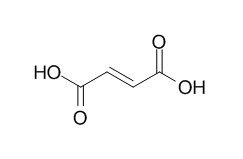Fumaric acid
Fumaric acid is an intermediate in the citric acid cycle used by cells to produce energy in the form of adenosine triphosphate (ATP) from food; also a product of the urea cycle.
Fumaric acid is used in systemic and topical treatment of psoriasis. Fumaric acid attenuates the eotaxin-1 expression in TNF-α-stimulated fibroblasts by suppressing p38 MAPK-dependent NF-κB signaling.
Inquire / Order:
manager@chemfaces.com
Technical Inquiries:
service@chemfaces.com
Tel:
+86-27-84237783
Fax:
+86-27-84254680
Address:
1 Building, No. 83, CheCheng Rd., Wuhan Economic and Technological Development Zone, Wuhan, Hubei 430056, PRC
Providing storage is as stated on the product vial and the vial is kept tightly sealed, the product can be stored for up to
24 months(2-8C).
Wherever possible, you should prepare and use solutions on the same day. However, if you need to make up stock solutions in advance, we recommend that you store the solution as aliquots in tightly sealed vials at -20C. Generally, these will be useable for up to two weeks. Before use, and prior to opening the vial we recommend that you allow your product to equilibrate to room temperature for at least 1 hour.
Need more advice on solubility, usage and handling? Please email to: service@chemfaces.com
The packaging of the product may have turned upside down during transportation, resulting in the natural compounds adhering to the neck or cap of the vial. take the vial out of its packaging and gently shake to let the compounds fall to the bottom of the vial. for liquid products, centrifuge at 200-500 RPM to gather the liquid at the bottom of the vial. try to avoid loss or contamination during handling.
Vietnam Journal of Science2022,64(2):69-75.
Front Pharmacol.2021, 12:615157.
PLoS One.2015, 10(5):e0127060
Chem Biol Interact.2019, 315:108910
Int J Biol Sci.2023, 19(10):3077-3098.
J Mol Med (Berl).2018, 96(7):661-672
J Chromatogr A.2022, 1685:463640.
Front Aging Neurosci.2019, 11:230
Biomed Pharmacother.2020, 128:110318.
J AOAC Int.2023, 106(1):56-64.
Related and Featured Products
Biotechnol Bioeng. 2013 Jul;110(7):2025-34.
Metabolic engineering of Escherichia coli for the production of fumaric acid.[Pubmed:
23436277]
METHODS AND RESULTS:
In this study, Escherichia coli was metabolically engineered for the production of Fumaric acid under aerobic condition. For the aerobic production of Fumaric acid, the iclR gene was deleted to redirect the carbon flux through the glyoxylate shunt. In addition, the fumA, fumB, and fumC genes were also deleted to enhance Fumaric acid formation. The resulting strain was able to produce 1.45 g/L of Fumaric acid from 15 g/L of glucose in flask culture. Based on in silico flux response analysis, this base strain was further engineered by plasmid-based overexpression of the native ppc gene, encoding phosphoenolpyruvate carboxylase (PPC), from the strong tac promoter, which resulted in the production of 4.09 g/L of Fumaric acid. Additionally, the arcA and ptsG genes were deleted to reinforce the oxidative TCA cycle flux, and the aspA gene was deleted to block the conversion of Fumaric acid into L-aspartic acid. Since it is desirable to avoid the use of inducer, the lacI gene was also deleted. To increase glucose uptake rate and Fumaric acid productivity, the native promoter of the galP gene was replaced with the strong trc promoter. Fed-batch culture of the final strain CWF812 allowed production of 28.2 g/L Fumaric acid in 63 h with the overall yield and productivity of 0.389 g Fumaric acid/g glucose and 0.448 g/L/h, respectively.
CONCLUSIONS:
This study demonstrates the possibility for the efficient production of Fumaric acid by metabolically engineered E. coli.
Food Chem Toxicol. 2013 Aug;58:423-31.
Fumaric acid attenuates the eotaxin-1 expression in TNF-α-stimulated fibroblasts by suppressing p38 MAPK-dependent NF-κB signaling.[Pubmed:
23707484]
In this study, we investigated the effects of Fumaric acid on eotaxin-1 expression in a mouse fibroblast cell line.
METHODS AND RESULTS:
We found that Fumaric acid significantly inhibited tumor necrosis factor-α (TNF-α-induced eotaxin-1 expression. This Fumaric acid effect was mediated through the inhibition of p38 mitogen-activated protein kinase (MAPK)-dependent nuclear factor (NF)-κB signaling. We also found that Fumaric acid operates downstream of MEKK3 during TNF-α-induced NF-κB signaling, which upregulated eotaxin-1 expression. In addition, Fumaric acid attenuated expression of CC-chemokine receptor 3 (CCR3), an eotaxin-1 receptor, and adhesion molecules that play important roles in eosinophil binding to induce allergic inflammation.
CONCLUSIONS:
Taken together, these findings indicate that inhibiting TNF-α-induced eotaxin-1 expression by Fumaric acid occurs primarily through suppression of NF-κB signaling, which is mediated by inhibiting p38 MAPK and suggest that Fumaric acid may be used as a complementary treatment option for eotaxin-1-mediated diseases.
Biotechnol Bioeng. 2015 Jan;112(1):156-67.
Fumaric acid production by Torulopsis glabrata: engineering the urea cycle and the purine nucleotide cycle.[Pubmed:
25060134]
A multi-vitamin auxotrophic Torulopsis glabrata strain, a pyruvate producer, was further engineered to produce Fumaric acid.
METHODS AND RESULTS:
Using the genome-scale metabolic model iNX804 of T. glabrata, four Fumaric acid biosynthetic pathways, involving the four cytosolic enzymes, argininosuccinate lyase (ASL), adenylosuccinate lyase (ADSL), fumarylacetoacetase (FAA), and fumarase (FUM1), were found. Athough single overexpression of each of the four enzymes in the cytosol improved Fumaric acid production, the highest Fumaric acid titer (5.62 g L(-1) ) was obtained with strain T.G-ASL(H) -ADSL(L) by controlling the strength of ASL at a high level and ADSL at a low level. In order to further improve the production of Fumaric acid, the SpMAE1 gene encoding the C4 -dicarboxylic acids transporter was overexpressed in strain T.G-ASL(H) -ADSL(L) -SpMAE1 and the final Fumaric acid titer increased to 8.83 g L(-1) .
CONCLUSIONS:
This study provides a novel strategy for Fumaric acid biosynthesis by utilizing the urea cycle and the purine nucleotide cycle to enhance the bridge between carbon metabolism and nitrogen metabolism.



